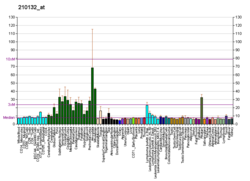| EFNA3 | |||||||||||||||||||||||||||||||||||||||||||||||||||
|---|---|---|---|---|---|---|---|---|---|---|---|---|---|---|---|---|---|---|---|---|---|---|---|---|---|---|---|---|---|---|---|---|---|---|---|---|---|---|---|---|---|---|---|---|---|---|---|---|---|---|---|
| Identifiers | |||||||||||||||||||||||||||||||||||||||||||||||||||
| Aliases | EFNA3, EFL2, EPLG3, Ehk1-L, LERK3, ephrin A3 | ||||||||||||||||||||||||||||||||||||||||||||||||||
| External IDs | OMIM: 601381; MGI: 106644; HomoloGene: 3635; GeneCards: EFNA3; OMA:EFNA3 - orthologs | ||||||||||||||||||||||||||||||||||||||||||||||||||
| |||||||||||||||||||||||||||||||||||||||||||||||||||
| |||||||||||||||||||||||||||||||||||||||||||||||||||
| |||||||||||||||||||||||||||||||||||||||||||||||||||
| |||||||||||||||||||||||||||||||||||||||||||||||||||
| |||||||||||||||||||||||||||||||||||||||||||||||||||
| Wikidata | |||||||||||||||||||||||||||||||||||||||||||||||||||
| |||||||||||||||||||||||||||||||||||||||||||||||||||
Ephrin A3 is a protein that in humans is encoded by the EFNA3 gene.
This gene encodes a member of the ephrin (EPH) family. The ephrins and EPH-related receptors comprise the largest subfamily of receptor protein-tyrosine kinases and have been implicated in mediating developmental events, especially in the nervous system and in erythropoiesis. Based on their structures and sequence relationships, ephrins are divided into the ephrin-A (EFNA) class, which are anchored to the membrane by a glycosylphosphatidylinositol linkage, and the ephrin-B (EFNB) class, which are transmembrane proteins. This gene encodes an EFNA class ephrin.
References
- ^ GRCh38: Ensembl release 89: ENSG00000143590 – Ensembl, May 2017
- ^ GRCm38: Ensembl release 89: ENSMUSG00000028039 – Ensembl, May 2017
- "Human PubMed Reference:". National Center for Biotechnology Information, U.S. National Library of Medicine.
- "Mouse PubMed Reference:". National Center for Biotechnology Information, U.S. National Library of Medicine.
- Cerretti DP, Lyman SD, Kozlosky CJ, Copeland NG, Gilbert DJ, Jenkins NA, Valentine V, Kirstein MN, Shapiro DN, Morris SW (Jan 1997). "The genes encoding the eph-related receptor tyrosine kinase ligands LERK-1 (EPLG1, Epl1), LERK-3 (EPLG3, Epl3), and LERK-4 (EPLG4, Epl4) are clustered on human chromosome 1 and mouse chromosome 3". Genomics. 33 (2): 277–82. doi:10.1006/geno.1996.0192. PMID 8660976.
- ^ "Entrez Gene: EFNA3 ephrin-A3".
Further reading
- Flanagan JG, Vanderhaeghen P (1998). "The ephrins and Eph receptors in neural development". Annu. Rev. Neurosci. 21: 309–45. doi:10.1146/annurev.neuro.21.1.309. PMID 9530499.
- Zhou R (1998). "The Eph family receptors and ligands". Pharmacol. Ther. 77 (3): 151–81. doi:10.1016/S0163-7258(97)00112-5. PMID 9576626.
- Holder N, Klein R (1999). "Eph receptors and ephrins: effectors of morphogenesis". Development. 126 (10): 2033–44. doi:10.1242/dev.126.10.2033. PMID 10207129.
- Wilkinson DG (2000). "Eph receptors and ephrins: regulators of guidance and assembly". Int. Rev. Cytol. International Review of Cytology. 196: 177–244. doi:10.1016/S0074-7696(00)96005-4. ISBN 978-0-12-364600-2. PMID 10730216.
- Xu Q, Mellitzer G, Wilkinson DG (2001). "Roles of Eph receptors and ephrins in segmental patterning". Philos. Trans. R. Soc. Lond. B Biol. Sci. 355 (1399): 993–1002. doi:10.1098/rstb.2000.0635. PMC 1692797. PMID 11128993.
- Wilkinson DG (2001). "Multiple roles of EPH receptors and ephrins in neural development". Nat. Rev. Neurosci. 2 (3): 155–64. doi:10.1038/35058515. PMID 11256076. S2CID 205014301.
- Kozlosky CJ, Maraskovsky E, McGrew JT, et al. (1995). "Ligands for the receptor tyrosine kinases hek and elk: isolation of cDNAs encoding a family of proteins". Oncogene. 10 (2): 299–306. PMID 7838529.
{{cite journal}}: CS1 maint: numeric names: authors list (link) - Davis S, Gale NW, Aldrich TH, et al. (1994). "Ligands for EPH-related receptor tyrosine kinases that require membrane attachment or clustering for activity". Science. 266 (5186): 816–9. Bibcode:1994Sci...266..816D. doi:10.1126/science.7973638. PMID 7973638.
- Gale NW, Holland SJ, Valenzuela DM, et al. (1996). "Eph receptors and ligands comprise two major specificity subclasses and are reciprocally compartmentalized during embryogenesis". Neuron. 17 (1): 9–19. doi:10.1016/S0896-6273(00)80276-7. PMID 8755474. S2CID 1075856.
- Ephnomenclaturecommittee (1997). "Unified nomenclature for Eph family receptors and their ligands, the ephrins. Eph Nomenclature Committee". Cell. 90 (3): 403–4. doi:10.1016/S0092-8674(00)80500-0. PMID 9267020. S2CID 26773768.
- Janis LS, Cassidy RM, Kromer LF (1999). "Ephrin-A binding and EphA receptor expression delineate the matrix compartment of the striatum". J. Neurosci. 19 (12): 4962–71. doi:10.1523/JNEUROSCI.19-12-04962.1999. PMC 6782661. PMID 10366629.
- Stein E, Savaskan NE, Ninnemann O, et al. (1999). "A role for the Eph ligand ephrin-A3 in entorhino-hippocampal axon targeting". J. Neurosci. 19 (20): 8885–93. doi:10.1523/JNEUROSCI.19-20-08885.1999. PMC 6782767. PMID 10516308.
- Strausberg RL, Feingold EA, Grouse LH, et al. (2003). "Generation and initial analysis of more than 15,000 full-length human and mouse cDNA sequences". Proc. Natl. Acad. Sci. U.S.A. 99 (26): 16899–903. Bibcode:2002PNAS...9916899M. doi:10.1073/pnas.242603899. PMC 139241. PMID 12477932.
| Intercellular signaling peptides and proteins / ligands | |
|---|---|
| Growth factors | |
| Ephrin | |
| Other | |
| see also extracellular ligand disorders | |
This article on a gene on human chromosome 1 is a stub. You can help Misplaced Pages by expanding it. |




